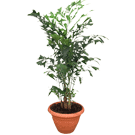





Botanical Name: Caryota mitis
Fishtail Palm gets its common name from the ragged-edged, ribbed texture of the dark-green leaflets that grow on upright stems. Its triangular leaflets are unique, and over time naturally split at the ends -- just like a fish tail.

Caryota mitis grows in a clump, with several stems rising from its base that can easily be divided.
I don't sell palms directly from this site, but I highly recommend Real Palm Trees.
They offer two sizes of this Fishtail Palm Tree, plus a variety of other small palms that are suitable for growing indoors. You can expect top-quality palms and excellent service. Best of all, your satisfaction is guaranteed with your purchase. You don't have to worry about ordering from this company.
Fishtail Palm tree is native to Southeast Asia, where it thrives in the warm temperatures and humidity of its tropical habitat.
This tropical palm is one of the easiest indoor palm plants to grow, requiring little care.
Add a little sand to the potting soil to speed up drainage. Use a ratio of 3:1 potting mix to sand. Use horticultural sand, not the type from the beach, which contains salts and impurities that can damage palms.
It is more tolerant of drier soil than overwatering. Put it in a container with a drainage hole. Water thoroughly then allow the soil to dry slightly between waterings.
Repot only when roots grow out of the bottom of the drainage hole. This palm prefers to be slightly pot-bound.
Brown leaf tips are likely caused by dry soil or -- more likely -- dry air. Use any practical means to increase the humidity around this palm. A room humidifier works best.
Do not prune palm trees unless an old branch dies. Palm trees grow from the tip of the branch. If you prune or pinch off the newest frond where it is attached to the stem, it will stop all new growth.
Grown as an indoor palm tree, it can reach 6 ft (1.8 m) indoors, therefore it needs some vertical space. This tree becomes more lush and attractive as it matures.
Origin: Burma, Malaysia
Height: Up to 6 ft (1.8 m)
Light: Bright light
Water: Water thoroughly then allow soil to dry slightly between waterings. Water less in winter when growth has slowed. Use filtered or distilled water because tap water may contain fluoride, chlorine and other chemicals that can damage palms.
Humidity: Average to moderate. If relative humidity drops below 50%, stand the pot on a humidity tray or use a room humidifier.
Temperature: Average to warm temperatures 65-85°F/18-29°C
Soil: Any good potting mix. Adding sand to the mix will help speed up drainage.
Fertilizer: Feed once in early summer with slow-release fertilizer. I like to use Jobe's Indoor Palm Fertilizer food spikes. It contains the micronutrients that palms need to keep them lush and green.
Propagation: Sow seeds in spring or summer, keeping the soil warm and moist. Offsets can be carefully cut away from the plant and potted in separate containers.
Copyright © www.100flowers.win Botanic Garden All Rights Reserved